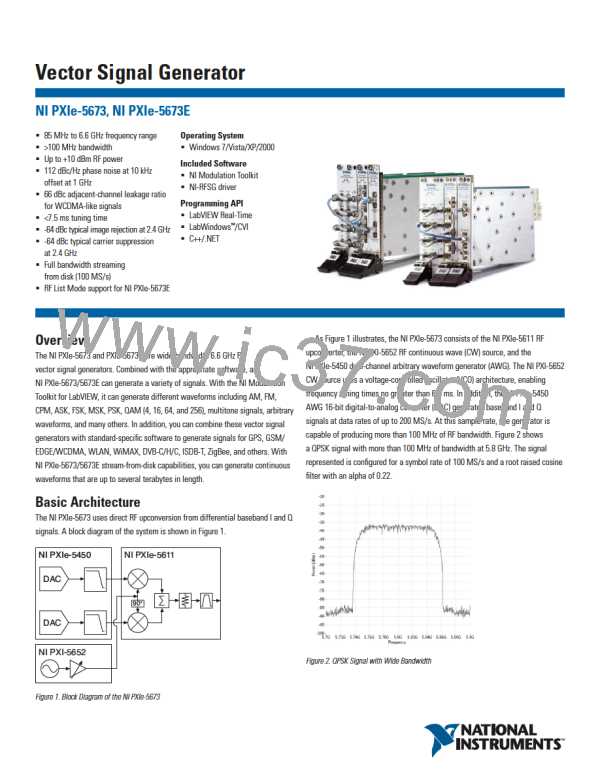Vector Signal Generator
Enhanced Architecture
RF List Mode
The NI PXIe-5673E (E for enhanced) offers additional performance and features
including RF List Mode support and configurable loop bandwidth for decreased
tuning times. As with the NI PXIe-5673, the NI PXIe-5673E comprises three
modular instruments. The NI PXIe-5450 is a dual-channel AWG that provides
16-bit digital-to-analog conversion and generates baseband I and Q signals at
data rates of up to 200 MS/s. You then can use an enhanced NI PXIe-5611 RF
upconverter with an NI PXIe-565x CW source acting as the local oscillator (LO)
for direct upconversion to RF.
The NI PXIe-5673E provides list mode support for fast and deterministic RF
configuration changes. You supply a configuration list, and the RF modules
proceed through the list without additional interaction with the host system and
driver, making the configuration changes deterministic. Figure 4 illustrates this
determinism with a single tone at 1 GHz stepping through six power levels in 7 dB
steps starting with -10 dBm and ending with -45 dBm and a 500 µs dwell time
specified for each step. Analysis was performed using the NI PXIe-5663E vector
signal analyzer.
With the enhanced NI PXIe-5673E, you can configure a wide- or narrow-loop
bandwidth for the VCO of an NI PXIe-565x. By using a wide-loop bandwidth, you
increase tuning time at the expense of additional phase noise; if you require
lower phase noise over faster tuning times for a particular measurement, you
can specify a narrow phase-locked loop (PLL) bandwidth for best performance.
You can achieve tuning times of less than 300 µs to under 0.1 ppm of the final
frequency when using the wide-loop bandwidth configuration.
Fast Waveform Downloads
One of the biggest advantages of PXI Express instrumentation is the benefit of
high-speed waveform transfer rates. Using an NI PXIe-5673/5673E, you can
download waveforms onto an instrument’s memory significantly faster than with
traditional instrumentation. Using a x4 PCI Express interface, you can download
waveforms to memory at speeds of up to 800 MB/s.
Figure 4. Deterministic 500 µs Power Steps Using the NI PXIe-5673E and RF List Mode
You can use the NI PXIe-5673E in both open- and closed-loop scenarios
to specify the source for the configuration trigger that advances from one
configuration to the next. In an open-loop situation, the NI PXIe-5673E advances
through the list based on a user-defined time specification for each step. The
closed-loop scenario relies on an external trigger that may be provided by the
device under test to advance through the RF configuration list.
Phase-Coherent Generation
The flexible architecture of an NI PXIe-5673/5673E enables multiple instruments
to share a common start trigger, reference clock, and even an LO. As a result, you
can synchronize up to four NI PXIe-5673/5673E RF vector signal generators for
phase-coherent signal generation. A typical configuration of two synchronized
generators is shown in Figure 3. With up to four channels of synchronized RF
signal generation, you can easily address MIMO and beamforming applications.
RF Record and Playback
You can combine an NI PXIe-5673/5673E with a PXI RF vector signal analyzer for
record and playback applications. Using a 2 TB redundant array of inexpensive
disks (RAID) volume, you can continuously generate up to 100 MHz (400 MB/s)
for more than 1.5 hours. In this application, an NI PXIe-5663/5663E vector
signal analyzer records up to two hours of continuous RF signal and the data is
stored as a binary file on a RAID volume. The NI PXIe-5673/5673E then streams
recorded waveforms from disk. In addition to recorded waveforms, you can use
streaming technology to generate large simulated waveforms.
NI PXIe-5450
DAC
NI PXIe-5611
90
˚
DAC
NI PXIe-5450
DAC
NI PXIe-5611
High-Performance Signal Generation
Higher-order modulation schemes such as 256-QAM require strong dynamic
range and phase noise performance. Using an NI PXIe-5673/5673E, you can
generate a variety of signals with significant accuracy. As shown in Figure 5,
a loopback configuration with an NI PXIe-5673/5673E and NI PXIe-5663/5663E
yields a typical EVM (RMS) measurement of 0.5 percent (1250 symbols, software
equalization disabled).
90
˚
DAC
NI PXI-5652
Figure 3. Simplified Block Diagram of Synchronized RF Vector Signal Generators
BUY ONLINE at ni.com or CALL 800 813 3693 (U.S.)
2

 NI [ National Instruments ]
NI [ National Instruments ]